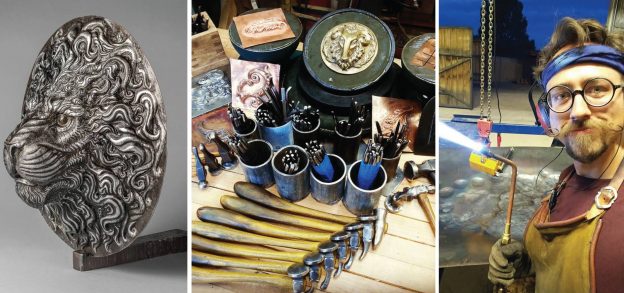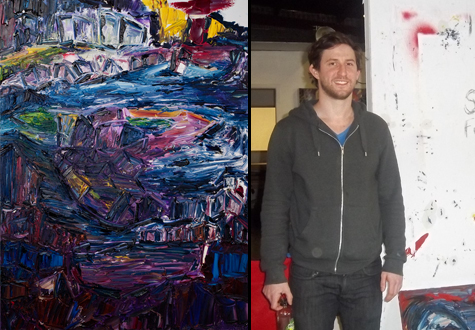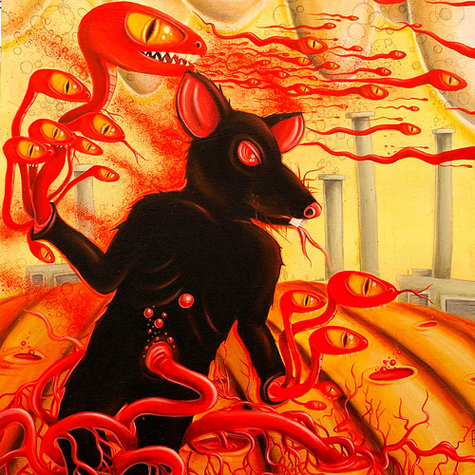You probably don’t know too many blacksmiths. I don’t. I don’t know any. But now I know Douglas Pryor, because he’s the shit at fucking with metal. He’s more metal than a rare Venom cassette at that thrift store in Orinda. He is a Sacramento guy you may not have heard of … yet.
Metallurgy and blacksmithing are something people can generally assume is done by a robot or a marginally paid worker in a place with chains and sparks flying everywhere to the glowing backdrop of molten metal pouring from a massive chalice.
“As I got into metal work, I was cutting grass as a kid, for a neighbor, and he had a coal forge in his backyard,” Pryor recalls. “I bought my first coal forge, bought my first shitty anvil when I was 16. I mean I didn’t have much, I had a ball peen hammer and a garage to use it in.”
So, a young Pryor peened away at his steel. Perhaps not surprisingly, it was the realms of fantasy that got Pryor first interested in metalworking.
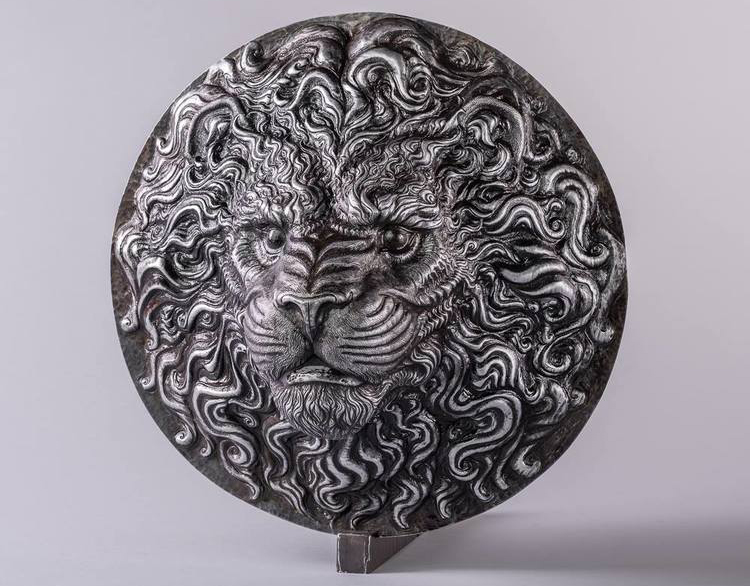
“When I was in high school, a lot of medieval movies were coming out,” Pryor says. “I think the first Lord of the Rings movie came out, and you know as kid, you’re all about it. You are slaying orcs in your head. I got a younger brother and dragged him everywhere and that sort of thing, and found some martial arts teachers that would teach us how to sword fight. That was OK, but I couldn’t afford my armor or anything, so I started learning how to make it, and that was one of the big reasons for getting into smithing at all, so I could sword fight competitively.”
As the appeal of clashing steel and honor lost its luster, he wanted to learn how to make his own armor; art born of necessity.
“But after the testosterone balanced out a little bit and that wasn’t so important, but I was still fervent about the metal work, because it turns everything into a blank canvas,” Pryor says. “So, I didn’t know what I wanted to do, but got hooked up at Sierra College. They’ve got an amazing welding program through the school, and I pretty much ran through all the programs, kept taking all their metal arts courses until I couldn’t take anymore. Learned enough to find out what I wanted to do next.”
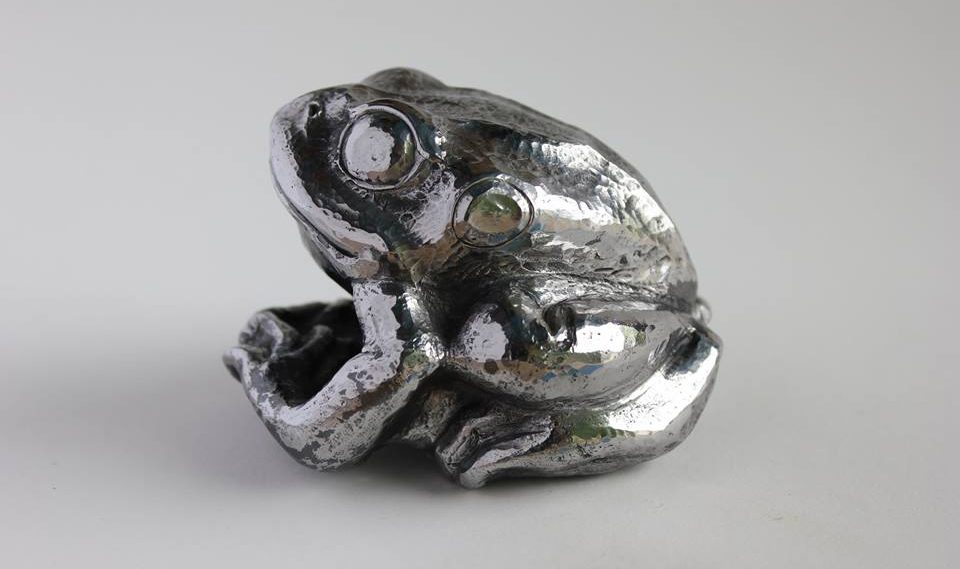
So Pryor decided to delve deeper into his craft. He learned more about welding and found inspiration in the art world.
“You look at these museum pieces, and they didn’t have a Miller Multimatic [welding system] around,” Pryor says. “How did they accomplish better sculpture than we are doing today?
“You learn all the answers to these questions and they leave you with more questions,” he goes on to say. “Where do you go when there’s no institution to teach these things? You’ve got to leave the institution and find people who know.”
That’s exactly what Pryor did. Founded in 1977, the California Blacksmithing Association has more than 600 members statewide. They offer resources such as job placement and classes, from level one, to certified instructor.
“I got hooked up with the California Blacksmithing Association,” he says. “A ton of the old guard is starting to go out, so they need new blood … it’s just like anything. If you don’t keep it alive and there’s no need to keep it alive … we’ll lose it.”
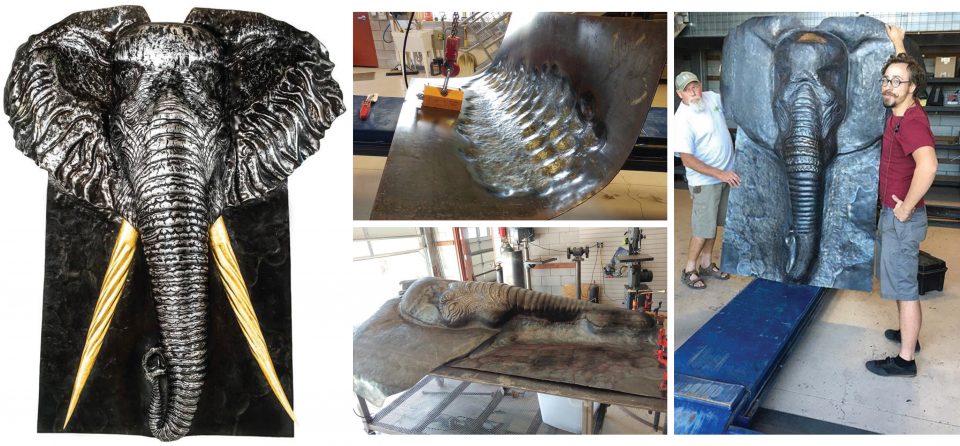
Pryor says he’s been fashioning armor for “10-plus years.” A quick perusal of his website will reveal that he’s achieved a high level of skill at his craft. Lion Head, with its fantastically flowing mane and rich oil patina, looks more like the work of some long-forgotten deity than a mere mortal. His equally awe-inspiring The Elephant, which Pryor has been working on through the mid-summer and early fall, is a mammoth piece (pun intended) fabricated out of a 6-foot-tall hunk of plate steel. In the future, Pryor says that there may be even more impressive works on the way.
“I worked with Tony Swatton,” he says. “He’s made all these swords for Pirates of the Caribbean, he made the hook from Hook. We worked on some stuff that will come out in 2019.”
Sculpting with metal is a skill that has been passed down through the ages, and Pryor does his part to keep the craft alive by offering classes. Working with steel may seem like a daunting task for the uninitiated (and it most likely is), but as Pryor puts it, it’s really just like any other art when you get right down to it. All you need is a willingness to work and a lot of imagination.
“Metals turn into blank canvases,” Pryor says. “And all your chisels become paint brushes, if you can draw you can chase.”
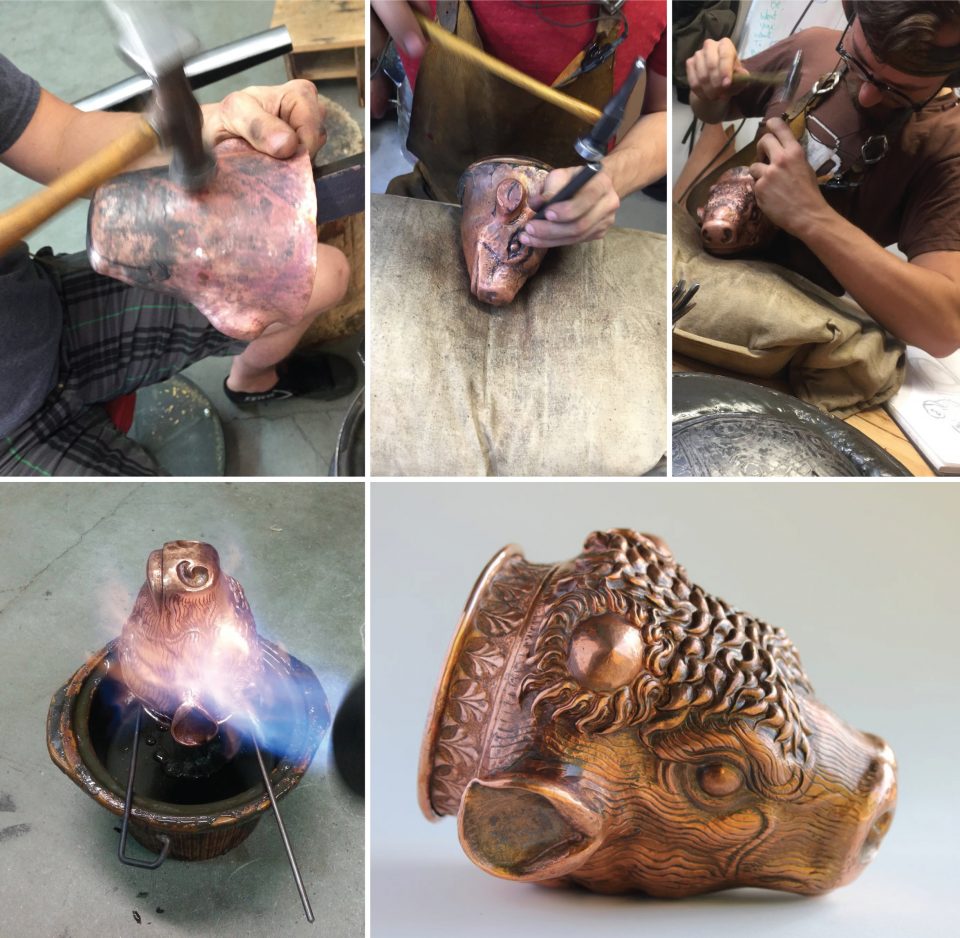
Heterogenous, a show featuring Douglas Pryor, Emerald Barkley, Elena Botts, Ivan Farmer and Bruce Gossett, will have its opening reception at FE Gallery (1100 65th St., Sacramento) on Oct. 14, 2017. Pryor will be performing a live blacksmithing demo at the reception. The show will run through November. If you’re interested in taking one of Pryor’s classes, check out his website Douglaspryor.com, or you can also follow him on Facebook @DouglasAPryor.
**This piece first appeared in print on pages 18 – 19 of issue #250 (Oct. 9 – 23, 2017)**
For Jon Mess, Music and Art Share a Similar Rhythm
Artist Jon Mess might be the only human example of going from zero to 60 and back in 3.5 seconds. One second he is thrashing paint on a canvas with quick and forceful strokes; the next he is stopping and staring intently at the chaos before him. He likes to start off a painting at a very fast pace but then slows down to analyze each stroke. At times he will stare at his work for more than 30 minutes.
For the past 10 years, Mess has experimented with various art forms including painting, graphic design, writing song lyrics even perfecting screamed vocals. His causal demeanor and laid-back personality make it seem surprising that his well-known talent is screaming lyrics in front of raving fans. He has been in the spotlight as a vocalist for Sacramento’s post-hardcore band, Dance Gavin Dance, but has been under the radar as a talented local artist. Each creative side of him represents the perfection of organized chaos; that can be heard in the vocals and seen in his art.
“I try and create a sort of rhythm with the strokes…like the way that music or notes would go up and down on a scale,” Mess said while sitting on a bench outside of his art studio. “I like the element of just going at it and moving real fast but at the same time I want to have balance and stability and take into account [the] formal element of art.”
His abstract artwork is full of bright colors and sharp strokes that leave no empty space on the canvas. Each piece of art is completely open to interpretation and everyone will have a different opinion on what the image is or what it means to them. It’s a “choose your own adventure” art show, Mess said. One minute you might see a rabid zombie dog but after a close examination you might see two eerie dark figures appear in the painting.

Horse, Oil on canvas 30’’ x 40’’ 2012
To get started on a painting, Mess lets his natural intuition and spontaneous side work together. “That’s one of the main things about my process is that I don’t work from an image or I don’t usually work from an idea,” Mess explained. “I put a mark on the canvas, then another one and then it starts to look like something.”
But if Mess does have a sporadic thought in his head it normally comes out as a painting, a lyric or sometimes both. From the most recent Dance Gavin Dance album, a song titled “The Robot with Human Hair Part 2 ½” contains three words that seemed to cause a small uproar with some of his fans.
“There is this one lyric that is ‘confusing ice cream cone.’ People were always misinterpreting or are confused as why the lyrics weren’t cohesive, just scatterbrained. Well, my lyrics are confusing ice cream cones,” he said. “Then I painted a big ice cream cone with a big question mark.
If it works, it fits in the song and fits on the canvas, why do I need more meaning than that? Why can’t I just paint anything?”
Having a creative process isn’t new in his family; in fact his artistic talent could prove that the creative gene might be a dominant one. Growing up he watched his mom sculpt clay vessels and “curvy vases”; he worked for his uncle, a veteran artist who builds massive metal creations; he is related to one of the animators of the legendary cartoon show The Simpsons; and his cousin works for the art department at UCLA.
“Why is everyone an artist? This must be genetic,” Mess said about his artistic family history. “My mom always had a studio attached to the house with kilns, a potter’s wheel, clay and paints. I learned and did sculptor clay when I was a lot younger and I starting painting when I was 16.”
Since then, he has completed many paintings that he is ready to share with the Sacramento community. Starting on April 14 the FE Gallery will display some of his work for his fans and art enthusiasts to enjoy. He is excited to move all of his artwork from his current studio (that he shares with other local artists in downtown Sacramento) and formally hang it in an official art gallery.
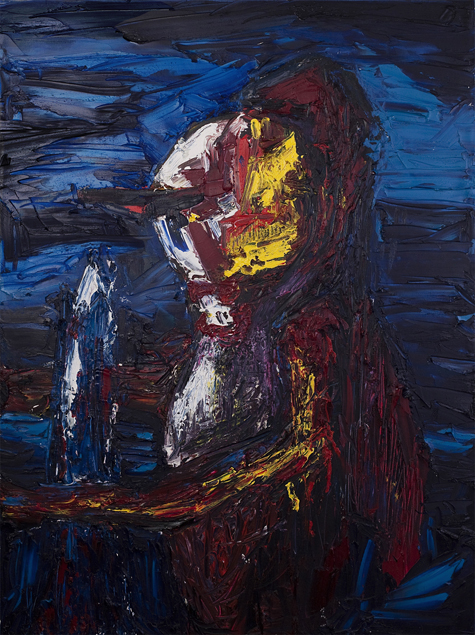
CominUp, Oil on canvas 30’’ x 40’’ 2011
The final product of the art show will have a completely different vibe than Mess’ current workspace. At first glance his art studio resembles an abandoned warehouse, but after walking inside and smelling the paint fumes, anyone could sense the hard work that surrounds the studio. The crowded building is divided into multiple messy workstations, and it’s hard to tell where one art station begins and where the other one ends.
But this environment is a recent upgrade from working at home in his apartment. “I was getting paint on the carpet, the walls, my hands, bathroom and my cat. [It] would get on him and he would track it around,” Mess said. “So out of necessity I had to move it all out. It’s been really nice.”
His upcoming show will be his first official gallery show, apart from college galleries at Sacramento State. While attending college, Mess studied electronic art and started to feel out his interest in post hardcore metal music. This slight interest and curiosity led him to become a famous hardcore screamer, a skill that he happened to pick up randomly.
“I didn’t know what I was doing at all at first and there was no real guidebook,” he said. “I asked a vocal coach at Sac State and they were like, ‘You are going to destroy your voice. You can’t do this. You’ll have no career.’”
If Mess had believed the unfaithful coach, he wouldn’t have toured with Dance Gavin Dance across the United States, and he wouldn’t have been called a “resident screamer” by Alternative Press. After being told he would have no career in screaming, Mess ended up headlining Sacramento State with his band almost right after his graduation date. But in terms of his future career, Mess is a little unsure of where his art will take him. He is going to “play it by ear” but doesn’t plan on slowing down anytime soon.
“I’m trying to stay within the creative field but in terms of what specific path it’s going to take,” Mess said. “I know that I can always just paint forever.”
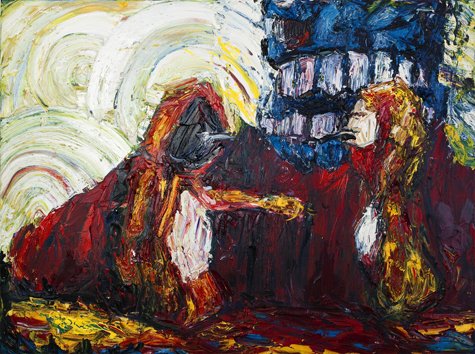
Washing, Oil on canvas 30’’ x 40’’ 2011
Check out the works of Jon Mess at FE Gallery. The exhibition will run through May 3, 2012. The gallery is located at 1100 65th Street, Sacramento and can be found online at http://www.fegallery.com/. If you’d like to see more of Mess’ artwork, go to http://jondmess.tumblr.com/.
In order to properly celebrate local artist John Stuart Berger’s 20-plus years of showing art in the Sacramento community, the Fe Gallery is hosting a music and art gathering with a few of Berger’s close friends. Berger is known for creating colorful abstract art depicting animals and insects that most people could only imagine in their dreams. The celebration begins Saturday, March 10, 2012 from 6 to 9 p.m. showcasing art from Skinner, Robert Bowen, Matt136, Kim Scott, Carrie Cottini, Allen Carrier, Mark Fox, Val Fernandez, Melanie Bown, Ianna Frisby and many more. Also, stay tuned for live performances by Sacramento musicians like Jackson Griffith, Bobby Jordan, Kevin and Allyson Seconds, Andy Sheppard and Kepi Ghoulie. For more information call (916) 456-4455 or visit Fegallery.com
On the art of Danny Scheible
Words by Bobby S. Gulshan
In the last few months of 2010, Sacramento’s Second Saturday Art Walk emerged as a hotly contested locus of debate. People wondered out loud if the event had strayed from its original mission; was the benefit to Midtown businesses and artists enough to justify the risks? Because opinions abound on both sides, we will likely not see any significant change to the Second Saturday event any time soon.
One thing, however, stood seemingly beyond contention: the art community is an important and integral part of the Midtown scene and of Sacramento in general. The amount of activity within the visual arts in Sacramento defies the notion that a vibrant art community that generates meaningful and important work can only exist within the major metropolises of New York or Los Angeles. To be sure, those cities remain important cultural centers if for no other reason than the sizes of the markets they inhabit. Yet, as artist and sculptor Danny Scheible tells it, there is something special about making art in Sacramento.
“You meet people here and they want to help you,” he says. “There is a community already there. Having been to bigger cities, it’s very much an exchange, what can this person do for me?” This sense of community, of art as the beginning of a practice of going beyond oneself, or perhaps toward some more complete version of the self, resonates centrally in Scheible’s work.
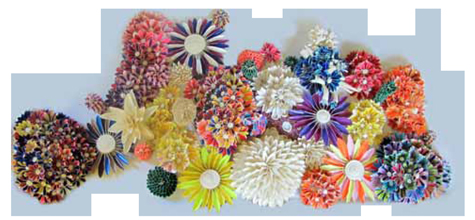
In sculpture, materiality and spatial context play vital roles in the interaction of the art object and its observer. As Danny and I spoke, he crafted flowers and other more abstract objects from rolls of masking tape. “Tape is something that everyone has in their house or wherever, so it’s something people can immediately identify with,” he says. “But it’s also about taking that everyday object and seeing the aesthetic potential in it.”
This intentional choice represents a movement toward the audience, toward their cultural and social location. With respect to spatial location, Scheible sees the importance not just of the gallery setting but of public space. While it brings with it some level of anxiety (things being damaged, openly criticized) venturing into public space is a further gesture toward the audience. In this case, it is to de-familiarize the everyday and punctuate it with an aesthetic gesture. “I might put a small piece out somewhere and then stand across the street and watch and see how people react, or I may leave things along my walking paths,” he says. Scheible will chronicle reactions, and these impressions further inform his process. In this way he is, as he says, “constantly creating myself as a person through my art.”
Scheible is the self-proclaimed “Art Ambassador of Sacramento.” His primary diplomatic function seems to be to inject into the experiences of his artwork–and thus himself–a dialogue or process by which further discovery can be made. “It’s a spiritual or meditative practice,” he says.
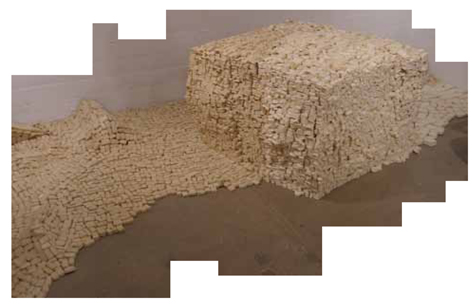
Many of our notions concerning modern sculptural works come from either our experience of sculptural objects in a gallery setting or the placement of sculptures in public places such as parks or commercial centers. These experiences tend to remind us of a kind of critical distance that exists between the object and the observer. In the case of minimalist sculptural works, the movement of the observer is a sort of theatrical gesture, but the object remains mute, having no specific relation to the audience other than its spatial fixedness. Scheible’s entire practice, and indeed process, seeks to reinvigorate this relationship with a certain kind of intimacy. In the works that he has given away, Sheible has encouraged others to produce drawings of his work that may subsequently be used as screen-print images, or alternately as hand drawn images, which again become the subject of his own process, as a sort of perpetual feedback loop. And this is key: The constant dialogue, or even dialectic, that generates the self through the process of offering forth the piece, having it reflected, and then taking that reflection as the starting point for the next iteration of work.
Scheible tells me, “I was born and raised in Curtis Park, and I live here now.” Locality is key to his process. The dialogue with the audience requires an immediacy that his interventions in space reveals. However, I don’t suspect that if Scheible keeps it up for long his bounds will be geographically limited. There exists a crucial point at which his art dares to reach into a universal realm: “An artist isn’t something you are born as, it’s something you make yourself into.” For Sheible, this is as much material and spatial as it is social. As he tells it, his strength lies in getting other artists to work together, to show together, and to promote together. This is a fundamental characteristic of anyone who dares to push the art that they believe in to the fore, and make it geographically and socially relevant.
We could have spent hours talking about the importance of public versus private space, or how hard it is for an artist to fix the damn scooter when it’s wrecked. But I look forward to an upcoming solo show, and the show he is curating, all here in our ever-vibrant Midtown arts scene.
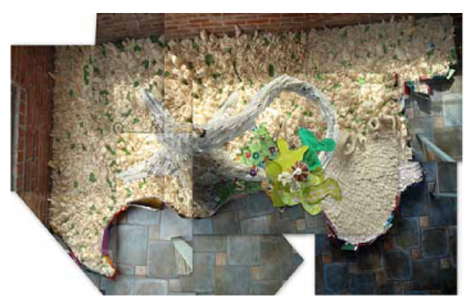
Danny Scheible’s latest solo show at Lauren Salon will have its opening reception during Second Saturday in March (March 12, 2011). Scheible’s curated show will take place at FE Gallery and will also have its opening reception on Second Saturday in March from 6 to 9 p.m.





